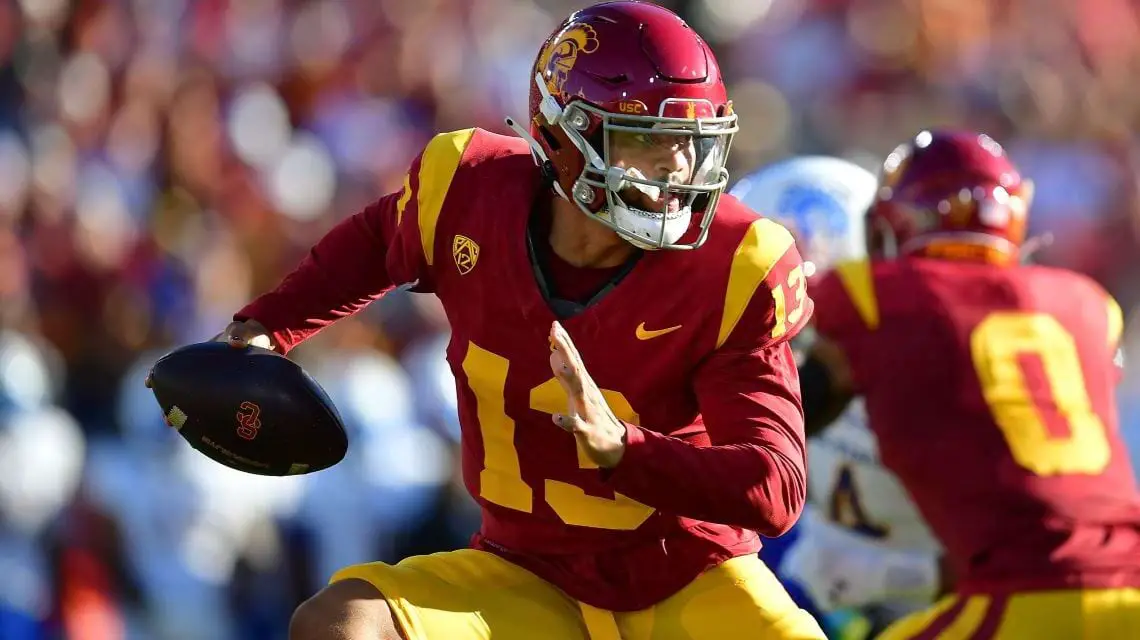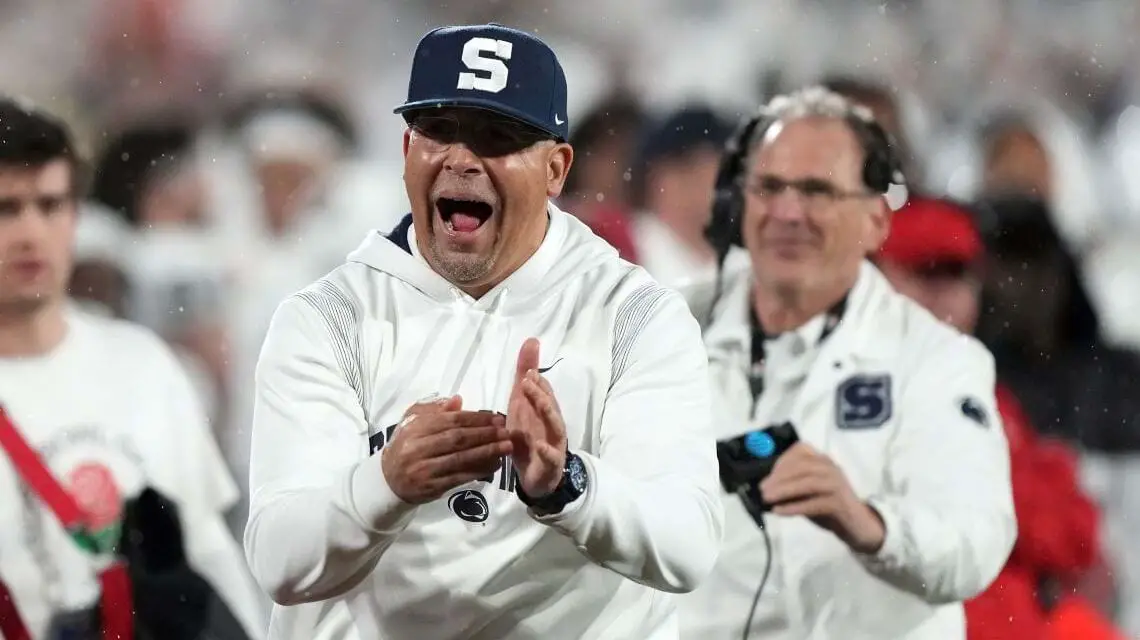
Gary A. Vasquez/USA TODAY Sports
It’s that time of year again. Preseason is coming to a close, and the long-awaited return of college football is upon us.
College football teams are already hitting the field, starting up the season with some big matchups right off the bat. In fact, USC and Notre Dame have already netted their first wins of the season.
But take note: college football games may look a little different this year due to new rules changes put into effect by the National Collegiate Athletic Association (NCAA).
If you’re a college football fan gearing up to kick off another season, you’ll want to make sure you’re up to speed on all the latest rule updates. Check out this guide to the rules which have been updated since last season.
What are the new college football rules for 2023?
The 2023 college football season is starting off with a few new rules in place.
These changes have been put into effect by the NCAA Playing Rules Oversight Panel and the NCAA Football Rules Committee.
There are a few key areas affected by these rule changes made since last year. Each of the following areas is described in more detail below:
- Game clock stoppage after first downs
- Consecutive timeouts
- First and third quarter penalties
- Second half warmup guidelines
- Instant replay
- Drone use
What are the new college football rules for game clock stoppages?
Beginning in the 2023 college football season, the game clock will continue to run after a first down is gained. The only time the game clock will be stopped following a first down is during the last two minutes of the first and second halves.
Previously, the game clock was stopped every time a team gained a first down, and then was restarted when the offense was awarded a first down by the referee placing a marker on the field. However, this can lead to longer game times, particularly when possession changes frequently during a matchup.
This season’s new game clock rule in NCAA college football actually resembles one of the game clock rules used in the National Football League. In the NFL, the clock also continues running after a first down with the exception of the last two minutes of the second and fourth quarters.
Why is the game clock rule after first downs being changed?
By implementing a running clock after most first downs, the NCAA Playing Rules Oversight Panel and the NCAA Football Rules Committee hope to reduce the total game time, which can often run over three and a half hours. The exception to the rule in the last two minutes of each half ensures that pivotal moments of the game aren’t rushed.
The new first down game clock rules were proposed as a way to control the flow of the game more effectively and aid in better game management. According to national coordinator of officials Steve Shaw, it will hopefully lower the number of plays overall, which could increase player safety by limiting their exposures to possible injuries.
Even a small reduction in plays can have a major benefit in reducing the number of player injuries. The NCAA Football Rules Committee estimates that the new rule will result in about seven or eight fewer plays per game. Over a typical 12-game season (not including playoff games), this means up to 96 fewer injury exposures per team.
The NCAA Football Rules Committee plans to closely analyze the effects of the new rule to see how it impacts the game experience for student-athletes, coaches, and fans alike.
The rule is only going into effect for for Division I and Division II football teams for the 2023 season. It will be implemented for Division III games beginning in 2024.
What is the new consecutive timeouts rule in college football?

Kirby Lee/USA TODAY Sports
Another major rule change for college football being implemented in 2023 applies to timeouts. Starting this season, teams can no longer call consecutive timeouts in the same dead-ball period.
Currently, teams are allotted three timeouts per half, each of which lasts about 90 seconds. Before, teams could call another timeout after one ended (permitting they still had one or more timeouts available). But as of 2023, team timeouts can’t be called back to back.
Consecutive timeouts are sometimes called in order to ice the kicker. This strategy refers to a defensive team calling a timeout before the ball is snapped to the kicker, who is about to attempt a field goal. By calling two or more timeouts before the snap, the team hopes to really rattle the kicker’s nerves and increase the chances of them missing the field goal.
To clarify, the new rules means that a single team can call only one timeout during a single dead-ball period. However, two timeouts are permitted in a single dead-ball period when one team calls a timeout followed by the other team calling one.
As with the new game clock rule, this new timeout rule for college football is similar to a rule in the NFL. Teams in the NFL can’t be granted two consecutive timeouts in the same dead-ball period.
Also like the new regulations for the game clock, it’s expected that some head coaches may be a bit upset about the new rule on back-to-back timeouts. However, the goal of both rules is the same: to help keep the game moving.
What is the new penalty rule in college football?
Beginning in the 2023 college football season, penalties which occur at the conclusion of the first and third quarters will carry over into the next quarter.
This means that game officials will enforce any penalties from the final play of the first quarter during the first play of the second quarter. Similarly, a penalty that happens at the end of the third quarter will be enforced at the beginning of the fourth quarter.
For fouls which happen at the end of the second and fourth quarters, the officials will extend the quarter with an untimed down to allow for the resulting penalty to go into effect. This is how all end-of-quarter penalties were handled prior to this rule update.
What is the new warmup rule in college football?
There are some new warmup guidelines going into effect for the 2023 college football season.
The NCAA has implemented a rule that, before warming up for the second half, teams must wait until the field is made available. According to this rule, the field must be made available for players to warm up at least three minutes before the kickoff of the second half.
In addition, each team must have designated areas of the field where they can warm up prior to the field becoming available. Any warmup activities happening before the field is ready must take place in these designated areas.
Once the three-minute warmup time begins, each team will have an L-shaped area of the field where they can prepare for the second half. This gives each team the full width of the field from the end zone through the 30-yard line on their end of the field along with half of the field extending to the opposite 30-yard line.
Other new rules in college football
Two other new rules for NCAA football involve the use of certain technology and devices during games. The following rules go into effect at the beginning of the 2023 season:
- Team without an instant replay booth official will have the option to use instant replay during games.
- No drone use is permitted over the field or the team areas when players are on the field.
What is changing in college football this year?
While there are a few new rules in place for college football, the overall game isn’t changing much. The rules are largely being put into effect to protect players and keep the game moving, not to make any substantial changes to the way the game is played.
Whether you’re rooting for a Big 12 team like Baylor or TCU, you’re a dedicated fan of Utah, Georgia, Florida, Texas or another Football Bowl Subdivision (FBS) team, or you’re just ready to see some on-field action after the offseason, keep these rule updates in mind while watching this year’s college gridiron matchups.